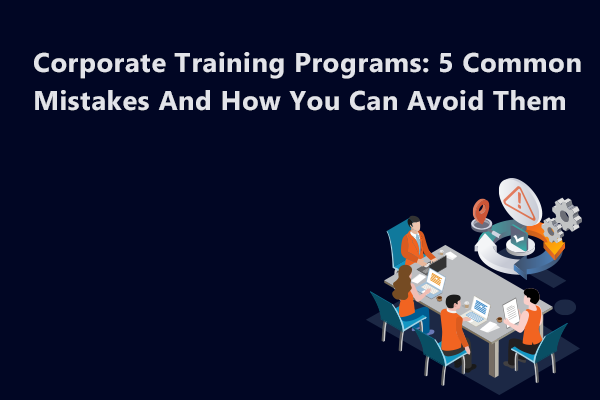
Corporate Training Programs: 5 Common Mistakes And How You Can Avoid Them
Over the last decade, organizations have increased their expenditure on corporate training. The market for corporate training grew from $247 billion in 2010 to $375 billion in 2020. Since the first wave of the COVID-19 pandemic hit us, companies have shifted to remote work. It led to everything suddenly moving online. Virtual corporate training programs have become very popular to engage, train and update employees. However, even efficient corporate training courses can go wrong. Let’s look into common mistakes:
- Coaches assume employees already have previous experience and knowledge even when they don't.
- Moving too quickly with mass information and spending very little time giving instructions and answering questions.
- Trainers fail to determine the best learning process for employees and are not available for them when they require it.
- Coaches distribute information following the easy path without trying to get into the depth of the subject matter.
- Trainers not using available online resources such as custom online learning tools. Instead, they pass information simply by reading from the book.
Common Corporate Training Mistakes
Here are some other common corporate training mistakes and ways to avoid them:
- Overloading Employees With Too Much Information Too Fast: The goal of corporate training programs is to train employees effectively and get them on board quickly. However, dumping people with information reserves is not always digestible. Trainers should know how humans learn and engage them through various ways to help them absorb the maximum amount of information. Effective training involves:
- Steady information flow using verbal, written, and discussion methods.
- Provide hands-on task performance for gaining practical knowledge and experience.
- Repeat the same tasks multiple times to help them retain as much information as possible.
- Track progress based on feedback and encourage constructive criticism to improve the learning process.
- Effective skill nurturing through observation, solving problems, and achieving mastery.
Corporate training courses does not just mean bombarding candidates with information. It involves delivering steady information at a speed at which candidates can grasp and retain it. It is also necessary to repeat tasks, provide reminders, allow feedback and constructive criticism for effective learning.
- Getting The Wrong Person As A Trainer: Selecting the right person as a trainer to deliver corporate training programs is the key to success. Sometimes, a person can be very knowledgeable but may not be able to teach others. Therefore, you need someone articulate and skilled enough to educate others in the most effective ways. Besides, trainers should be available and accessible. An open-door policy of training where trainees can approach coaches anytime without hesitation and their questions solved is best for learning. Trainers should also recognize the learning speed and style of each candidate and deliver instructions accordingly for the best learning experience. Therefore, one of the best ways for effective training is through online methods. Virtual learning tools can track progress, reduce costs, fit into all objectives and permit learners to progress at their own pace.
- Irrelevant Training Using Single Focus: Often training programs teach candidates how to go about their job. It teaches employees the basic requirements of their position and the tools needed to accomplish a given task. However, understanding the reason behind everything is crucial to empower employees and train them effectively in verbal and problem-solving skills. The answer to this common corporate training mistake is simple. Provide a rationale every time you’re asking an employee to do something so they understand how the training is making a difference.
- Not Meeting Employee Expectations or Adapting To Their Needs: Employees can have specific needs. They can face personal challenges like struggling with user interface and technical barriers related to online training. Therefore, it is vital to create a simple interface that is easy to understand and access by all candidates. Besides, every employee learns differently. For instance, one individual may love attending a lecture while another may get restless and lack attentiveness. Therefore, it is essential to make training engaging and entertaining for everyone. Thus, micro-learning or individualized & custom training and learning paths work the best.
- Not Improving Existing Training Program: It is essential to ask for feedback from your previous trainees about their experience and future expectations. Although the answers may be shocking, it is necessary to know how effective your corporate training program is. Ensure to create a regular follow-up and review system for trainers and trainees to gain insight into your training strategy and to check if you are using the best online training tools available. During training indulge in appreciation, and constructive criticism, conduct surveys, and periodic assignments to get a complete picture of the efficiency of your training program.
Conclusion
Employee training is a vital step in achieving business goals and a safe work environment. Visit https://www.learnow.live/ today to know more about virtual corporate training programs and implement them at your workplace to avoid the usual shortcomings of corporate learning mistakes.
